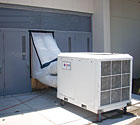
The Model 12T unit from Spot Coolers “was essentially ready to work for our needs, as is,” said Ray Gaffey, Cocoon VP of operations and a principal of Cocoon Inc., the company that provided an environmental solution for the DOD’s custom deployable hangars (not shown here).
Similarly, any competent air conditioning or mechanical contractor can provide a cooling system for a typical building. They size the equipment for the load; install a duct system for adequate air distribution, and in most cases the problem is solved. But whom do you call when your structure has specific requirements and does not resemble anything you have ever cooled before?
You might want to ask the Department of Defense (DOD). When they had to provide an environmental solution for their custom deployable hangars, they called on Cocoon Inc. Used to store and maintain high-tech helicopters, instruments, and sophisticated ordinance for short-term deployment, these hangars are used in applications around the world. Inside of them, proper environmental control is critical and the equipment has to be operational and reliable in extreme elements or conditions.
Based in North Hampton, N.H., Cocoon often gets called upon to provide environmental solutions for the Maritime Administration, NATO, and various other federal agencies. Consisting of a core group of 12 engineers and specialists with dehumidification and environmental control expertise, they often collaborate with a network of “teaming partners” - outside companies with complementary knowledge - to provide custom solutions for a variety of applications.
Project management for the hangar project was headed up by Ray Gaffey, Cocoon VP of operations and a principal in the company. From the beginning, the project proved to be challenging. “We had to design a system that would work anywhere in the world” said Gaffey. “And yet, the customer could not disclose where it would be deployed or what would be housed in the structure. All information was confidential.”
Once the company received design parameters from the DOD, the specifications contained numerous challenges. The tolerances for temperature and humidity ranges were very narrow. There also were physical (size, weight, and capacity) constraints.
The equipment had to be small and light enough to be transported in containers and transport aircraft. And yet it had to be heavy-duty enough to withstand the rigors of the elements, including sand, wind, and extreme temperature.
STEP-BY-STEP
Step one was the search for the appropriate air conditioning platform. Ray consulted with his team partners; together they developed a short list of possible vendors. Due to time and cost constraints, the preferable solution would consist of an existing platform that required minimal modification. A month of rigorous search and manufacturer interviews ensued before he found the ideal platform for the solution in Spot Coolers’ 12-ton mobile unit. Model 12T, sold by Spot Coolers Transportable Temperature Systems’ Custom Build Division, possessed most of the features required in the project specifications without major or costly modifications.“The Spot Coolers 12-ton unit was essentially ready to work for our needs, as is,” said Gaffey. “Minimal integration was needed. We engineered a larger cart for mobility with a dehumidification feature for other applications. We designed and built plenums and other accessories to connect to the structures duct system. Beyond that, the 12T worked well.
“Working with the Spot Cooler personnel was also seamless,” he continued. The company was “very responsive all along the way. Questions relating to design, performance, and efficiency were answered quickly and never delayed the project. Delivery of the product was within the time frame required. And the accuracy of their claims also held up when the equipment was put to the test,” Gaffey said. “This was very important to me because, as a supplier, we pride ourselves in meeting deadlines. We also make claims that must be accurate - things must work as we say they’ll work.”
The DOD was pleased with the results. To date, the hangars and support equipment have been deployed multiple times for one- to two-month stretches. These deployments occurred in the desert and tropical theatre locations worldwide and have gone without a hitch. The equipment worked as specified.
Gaffey is presently working with Spot Coolers on the next-generation unit. The goal is to standardize the package with minimal modifications.
“Our customer is looking to invest in a boatload of these hangars,” said Gaffey.
“They’re going to need a lot more environmental control units like the ones we have provided so far. We are looking to Spot Coolers as the primary vendor of this equipment going forward.”
Publication date:06/28/2010

Report Abusive Comment